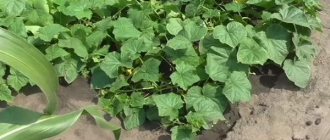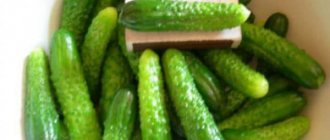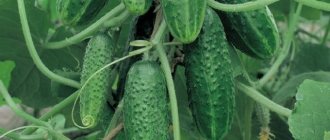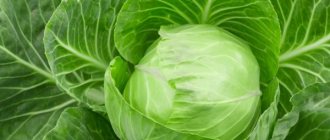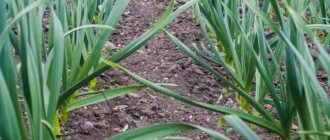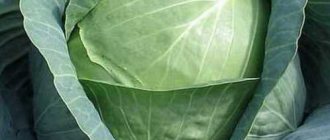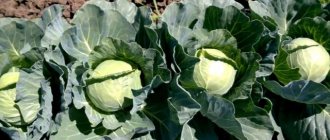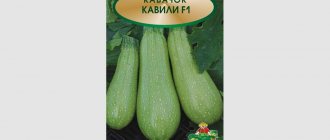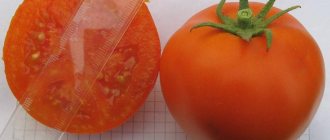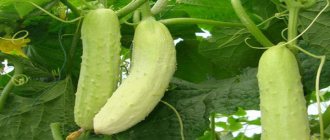Among the early ripening cucumber varieties, a new product recently appeared, which immediately attracted the interest of not only ordinary gardeners, but also farmers who grow this delicate vegetable for sale. We are talking about the Mamluk cucumber. Specialists from the Research Institute of Vegetable Crops Breeding LLC and the Gavrish Breeding Company LLC worked on its creation. Authors: S.F. Gavrish, A.E. Portyankin, A.V. Shamshina, V.N. Shevkunov, N. N Khomchenko, T.Ya. Surovova, I.S. Pluzhnik. The variety was included in the State Register of Breeding Achievements of Russia in 2012 and received approval in all regions of the country. Recommended for growing under film covers in private farms. Perfect for use in late winter-spring and summer-autumn rotations in greenhouses. It is considered the standard of lumpy cucumber for cultivation in summer and autumn. The variety is popular not only in Russia, but also in Moldova and Ukraine. Mamluk is a hybrid and is therefore always labeled F1.
Description of the Mamluk cucumber variety
To understand whether a new plant is needed for planting next year, you will need to study the description and main characteristics of the Mamluk F1 cucumber.
Plants are parthenocarpic; they do not contain seeds suitable for propagation. The hybrid has a large number of side shoots. The main vine reaches 2.5 m, the side ones - about 1 m. The height of the Mamluk cucumber when grown in a greenhouse or in open ground must be normalized in order to increase productivity.
Hybrid Mamluk refers to early ripening plants, or, as people say, early ripening cucumbers. The first fruits are harvested 35-40 days after germination. Fruiting lasts almost 2 months. The taste is excellent throughout the entire period.
The leaf blades are large, rich green, heart-shaped. Mamluk cucumber is distinguished by strong peduncles that are firmly held on the shoot. The inflorescences are mainly of the female type, bunched, with usually 2-3 ovaries in the internodes. All cucumbers are the same length - 10-14 cm, their diameter is 2.5-3 cm. Each fruit weighs 110-130 g.
Important! Cucumbers hanging on the shoots do not ripen for a long time and remain rich green.
The surface of cucumbers is dense, but not hard, with low tubercles. The fruits of the variety are green, each of them has longitudinal white stripes. Cucumbers are distinguished by their juicy, crunchy flesh and their taste is sweetish, without bitterness. There are seeds in the fruits, but they are small and underdeveloped.
Advice! To get more new ovaries, harvesting greens should be done every other day.
Agricultural technology or proper cultivation: sowing seeds for seedlings, picking
Mamluk F1 cucumbers are grown without seedlings. The seeds are planted immediately in the greenhouse. For successful growth, it is necessary to meet deadlines, choose a suitable location and sow the material in the correct pattern.
Hybrid Mamluk F1 is suitable for double rotation (winter-spring and summer-autumn). When landing, the air should warm up to 18°C. The optimal soil temperature is 10... 12°C.
In the middle zone, the timing of seedless planting is as follows:
- January for winter-spring turnover;
- second half of June for summer-autumn turnover.
The strong root system of the Mamluk F1 hybrid allows the crop to be planted in any type of soil. There are also no special whims when it comes to lighting. You should not immerse the bushes completely in the shade, but the lack of bright lighting will not harm the cucumbers. Thanks to this parameter, they can be planted in winter.
When choosing a location, you should avoid windy places and close proximity to groundwater. But since the hybrid is intended for greenhouse cultivation, there should be no problems. Greenhouses are built in places suitable for growing vegetables. They also protect the plantings from windiness.
For the growth and productivity of cucumbers, it is important to follow the rules of crop rotation. The following are considered good predecessors:
The following are considered good predecessors:
- garlic;
- corn;
- early white cabbage;
- legumes;
- cauliflower;
- onion.
- tomatoes;
- turnip;
- eggplant;
- carrot;
- white cabbage of medium and late varieties;
- pepper.
You also need to choose the right neighbors in the garden.
It is not advisable to grow cucumbers in the same place for many years in a row. If the gardener has one greenhouse at his disposal, he can plant green manure herbs after harvesting.
The technological process of growing the Mamluk variety (F1) in heated greenhouses has its own characteristics. Seeds for seedlings begin to be sown in the last ten days of December. In February, the seedlings are moved to a heated greenhouse. For rapid germination and friendly germination of seeds, the temperature in the greenhouse is maintained at least 25°C.
After the first true leaves appear, the temperature is reduced to 20-22 degrees. Experienced vegetable growers recommend providing round-the-clock lighting for 7-10 days.
The distance between cucumbers should be at least 50 cm.
Mamluk is able to show his best results only indoors. It can also be grown outdoors, but the yield will be slightly lower, and the greens may have a curved shape. Seeds are sown in April – May. Caring for seedlings does not differ from the generally accepted practice. Planting pattern: 50 cm between bushes, 50 cm – row spacing.
The culture is very unpretentious. The powerful and quickly regenerating root system is capable of growing on any type of soil, including coconut or mineral wool. The plant loves to be watered; moisturize with warm water. During the growing season, cucumbers are fed at least 3-4 times, using balanced mineral fertilizers or organic matter.
Hybrid Mamluk is an excellent choice not only for personal farming. With the help of an unpretentious and productive crop that bears highly marketable fruits, you can get a good income. Good immunity will make it easier to care for the plant, although you should not completely abandon preventive treatments.
Pros and cons of the Mamluk variety
One of the characteristics of a variety is its positive or negative sides.
Benefits of Mamluk cucumber:
- stable and high productivity with friendly returns;
- unpretentiousness of care;
- full-fledged ovaries are formed both in open and protected ground, regardless of whether there are pollinating insects or not;
- The taste qualities of Mamluk cucumbers, according to consumer reviews, correspond to the description; even with a short-term drought, no bitterness is observed in the fruits;
- the transportability of the fruit is high, the presentation does not suffer during long-term transportation;
- ripe cucumbers remain green for a long time and do not turn yellow;
- universal use of fruits;
- good resistance to diseases and crop pests;
- high shelf life without loss of taste.
Unfortunately, breeders were unable to avoid disadvantages when creating a hybrid. Although they are few and far between, they exist.
Flaws:
- It is impossible to obtain seeds from the fruits of the Mamluk variety at home; planting material must be purchased annually. And their cost is high.
- Even slight frosts can destroy plants.
Optimal growing conditions
In order for Mamluk cucumbers to develop well and bear fruit, you need to take care of the growing conditions. They are almost the same for all crop varieties:
- You can sow seeds when the soil warms up to +12 degrees. At lower rates, the seed will lose viability.
- When growing in a greenhouse, you need to monitor the air humidity.
- To germinate seeds, you will need an air temperature of about +27 degrees.
- When sprouts appear, the indicator is reduced to +25 degrees so that the seedlings do not stretch.
- Mamluk cucumbers are demanding on lighting.
Mamluk F1 cucumber growing technology
Agricultural technology for growing Mamluk cucumbers is not difficult even for beginners. Seeds for seedlings are sown from April to May, depending on the region of residence. Since the plants are heat-loving, planting in a greenhouse or open ground is carried out after the onset of stable heat.
Attention! The Mamluk cucumber variety can be grown all year round in heated greenhouses without loss of taste and commercial qualities.
Direct planting in open ground
The hybrid can be grown by seedlings or direct sowing in open ground. The time for sowing cucumber seeds to obtain early green products depends on the climatic conditions of the region. In the south, work can be planned for April, in temperate climates - at the end of May. In the risky farming zone, seeds are sown in the second ten days of June.
Attention! To obtain a late harvest of cucumbers, planting can be repeated at the end of July in order to harvest cucumbers in September.
Growing by seedlings
To collect greens in early June, it is recommended to grow the Mamluk variety through seedlings in closed ground. Since a little over a month passes from the moment of germination to the harvesting of the first cucumbers of the Mamluk variety, the seeds should be sown in mid-April.
For sowing you will need nutritious soil. You can use a ready-made one by buying it in a store. If you compose the soil yourself, then, in addition to garden soil, humus or compost, sand and wood ash are added to the mixture. A week before sowing, the soil is spilled with boiling water with the addition of several crystals of potassium permanganate to destroy spores of diseases and pests.
Cucumber seeds are pickled in a pink solution of potassium permanganate or Fitosporin. You can grow seedlings in boxes, but it is better in cups, since seedlings do not tolerate transplantation well.
Plant 2 seeds into each cup to a depth of 3 cm. Cover the containers with film to speed up germination. When the sprouts appear, the cups are placed on a lighted window.
Important! If cucumber seedlings do not have enough light, they will have to be additionally illuminated with phytolamps.
By the time of transplantation, Mamluk cucumber seedlings, according to the description of the variety, should have 2-3 leaves, as in the photo below. Healthy plants are distinguished by lush green leaf blades without signs of diseases and pests.
Caring for cucumber seedlings comes down to moderate watering, superficial loosening of the soil and fertilizing with green fertilizer and wood ash extract. Before planting in a permanent place, plants are hardened off so that they develop successfully in new conditions.
Watering and fertilizing
Any varieties of cucumbers require watering, since they themselves mostly consist of water. For irrigation, only warm water is used. If you have a greenhouse, then watering containers can be installed in it.
At first, the bushes are watered once every 6-8 days. When fruiting begins, the frequency of watering is increased - every 3-4 days.
Irrigate only at the root, since moisture on the leaves can provoke fungal diseases.
As for fertilizing, in recent years gardeners have been striving to obtain environmentally friendly products, so they give preference to organics:
- mullein solution;
- wood ash extraction;
- infusion of fermented green herbs;
- foliar feeding with iodine and boric acid.
Cucumber plantings are fed taking into account the condition of the plants. If the soil is well-filled with organic matter, then at the initial stage you can get by only with foliar fertilizing and sprinkling the soil and leaves with dry ash.
Important! Feeding cucumbers at the root is carried out on previously spilled soil.
Formation
The hybrid can grow indefinitely in height, but part of the harvest is lost. That's why cucumbers are specially shaped. At a height of 25 nodes, the main stem is pinched so that increased growth of side shoots with ovaries begins. The first stepsons and ovaries located under the 2-3rd leaf are removed. The remaining side shoots produce 1 bouquet of ovaries. The next shoots are pinched, leaving 2 bunches and so on. The last side stems are shortened at a length of 90 cm.
Attention! The pinching procedure is important for the Mamluk cucumber variety; it allows for faster formation of ovaries in subsequent internodes.
Features of cultivation
The methods of cultivating the Mamluk hybrid are not much different from the methods of growing other varieties.
To get a good harvest of Mamluk cucumbers, you need to take the seeds and place them in moons prepared in advance at an angle of 45 degrees. The depth of planting the seeds is no more than 3 cm. Thanks to this position of the seeds, the sprouts will break through to the surface of the earth in the shortest possible time.
The best time for planting seeds is the end of April and the beginning of May, since by this time the soil has warmed up to the required temperature, which is 12°C. Cucumbers must be tied to trellises.
The technological process of cultivating a hybrid in heated greenhouses has its own characteristics. Seeds for growing seedlings begin to be sown at the end of December, and in February the grown seedlings are planted in a heated greenhouse. For quick and friendly germination of cucumber seeds, they need an air temperature of at least 25°C. With the appearance of the first leaves, the temperature is lowered to 20-22°C and 24-hour lighting is provided for one week.
Drip irrigation scheme
The relative humidity in the room with seedlings should not exceed 75%.
Cucumbers should be planted at a distance of 50 cm from each other, tying each of them to a trellis.
Another feature of cultivating Mamluk F1 cucumber is the need for proper formation of the bush. It is formed into one trunk, despite the small number of ovaries formed. The four lower leaves are cut off completely along with the ovaries. Next, only one ovary and one leaf are left.
Tomato variety “Red Pear”: description, characteristics, sowing seedlings, fertilizing, yield, photos, videos and the most common tomato diseases
There is also a seedless method of sowing seeds, that is, the seed must be planted directly in the prepared bed. Before sowing, the seeds need to be soaked in a solution of a growth stimulator. The soaking time depends on the type of solution, in any case it will not exceed 24 hours. After this, the seeds can be planted. The main rule for planting cucumbers directly in the garden bed is that the soil on it must warm up thoroughly. And this, as a rule, happens at the end of May or at the beginning of June. In addition, at this time the risk of frost is reduced to zero. Only in this case will the hybrid please the gardener with fast and friendly shoots.
Seedless sowing method
During fruit ripening, the daytime air temperature should not be lower than 25°C, and the night temperature should not be 18°C.
The cucumber crop needs to be watered regularly and quite abundantly, only with warm water.
Diseases and pests
The originators took care of the hybrid's immunity to many cucumber diseases. So, Mamluk has high resistance to:
- parasporosis;
- cladosporiosis;
- root rot.
But damage to Mamluk cucumbers by diseases such as anthracnose, powdery mildew, and fusarium cannot always be avoided. To spray plantings, you can use biological preparations that are safe for humans and beneficial insects:
- "Trichodermin";
- "Fitosporin".
For pests such as aphids and spider mites, it is better to use folk remedies:
- infusion of garlic or onion peel;
- decoction of wormwood or Bogorodskaya herb.
In a greenhouse or in cucumber beds, experienced gardeners hang tea bags soaked in iodine. Pests don't like the smell. Folk remedies do not harm either the plants with ovaries themselves or humans.
The drug "Guapsin" can be used as a prophylactic agent. When spraying with chemicals, you must use protective equipment.
Care
The culture is unpretentious to weather conditions and has good immunity to diseases. Powerful roots grow well in any soil, even rock wool and coconut.
Watering
Cucumber loves moisture, but you should not flood the soil, because... The root system may begin to rot. Water in the morning or evening to prevent water from forming a crust on the soil in the sun.
The water should be at room temperature: no matter how strong the roots of the bush are, they will begin to rot. Pour exclusively onto the ground, not onto the leaves.
Top dressing
Mineral: Plantafol (helps strengthen the plant’s immunity), Terraflex-S (for better fruiting), Superphosphate, Master. Organic: manure solution (1:7), water infused with green grass), chicken manure diluted with water (1:10).
Plants need to be fertilized 4 times a season:
- 12-15 days after planting in prepared soil, to strengthen the plant;
- during the flowering period of cucumbers;
- during the period of appearance of the first fruits (to activate fruiting);
- as necessary to prolong the fruiting process.
When fertilizing, it is important not to overdo it. You need to follow the instructions exactly, remembering that too much fertilizer can negatively affect the growth and development of cucumbers
Topping
Excess shoots must be removed
You need to pin the bush from 11-12 leaves. Remove all shoots that have formed and leave only the ovaries. Then all the shoots need to be pinched after the first leaf, where the ovary has formed.
After approximately 25 leaves, the main stem should be pinched to limit further growth of the bush.
Weeding and loosening
When loosening the soil, the soil is saturated with oxygen and better allows moisture to pass in, which is very beneficial for the root system.
The main amount of small weed is removed, which takes away nutrients and moisture. The soil should be loosened 2-3 times a season, trying not to damage the root system.
Disease and pest control
According to the description, Mamluk is susceptible to attack by bacteria that arise due to improper care of the cucumber (high humidity, little light, etc.).
- Powdery mildew. The appearance of white-gray spots on the leaves, which lead to drying out of the plant. Appears from excess moisture. To eliminate the disease, use the fungicidal drug Topaz (2 g per 10 liters of water). This remedy is also suitable for the fight against copperhead and peronosporosis. You can spray the bushes with sour milk diluted with water.
- Cladosporiosis. A fungal disease of cucumbers that affects the leaves and fruits with brown bulging spots, which also leads to the death of the plant. The drugs Oxychom and Fundazol are well suited for the fight.
- Root rot. The root gradually begins to rot and becomes sluggish. The reason lies in excess or lack of moisture, sowing density, and low temperatures. The first thing to do to save the bush is to pour fertile soil onto the lower part of the stem. This will help the plant develop new, healthy roots.
To prevent diseases, you can use folk remedies, spraying the bushes with salt water or a solution of potassium permanganate, or sprinkle with wood ash to repel insects.
If you properly care for cucumbers, the likelihood of them getting sick or being damaged by pests is minimal.
Cucumber hybrids F1 Mamluk
Winter cucumbers. 6 acres 04/02/2018
Mamluk cucumbers from the Gavrish company
Reviews of Mamluk cucumbers
Ekaterina Viktorovna Gorbets, 37 years old, Yaroslavl.
I have a heated greenhouse in which I grow Mamluk cucumbers throughout the year. The fruits are in demand in the market. I grow each new batch through seedlings. This speeds up the harvest by 2 weeks. I grow the Mamluk variety of cucumbers on a trellis with the obligatory tying of the shoots. The variety is distinguished by the fact that the ovaries never fall off. Despite the fact that in winter you have to spend money on heating the greenhouse, the sale of early cucumbers in winter and early spring pays for itself.
Evgenia Osipovna Lebedeva, 47 years old, Irkutsk.
I grow different varieties and hybrid forms of cucumbers in open ground and in a greenhouse for my own needs. I bought Mamluk seeds 3 years ago. I liked the variety for its productivity and tasty juicy fruits that never taste bitter. We pick the first cucumbers in mid-June and continue collecting until frost. The hybrid hardly gets sick, grows quickly, looks beautiful due to its green leaves and clusters of fruits. The only drawback is that it is impossible to obtain Mamluk cucumber seeds at home; you have to buy them in the store.
